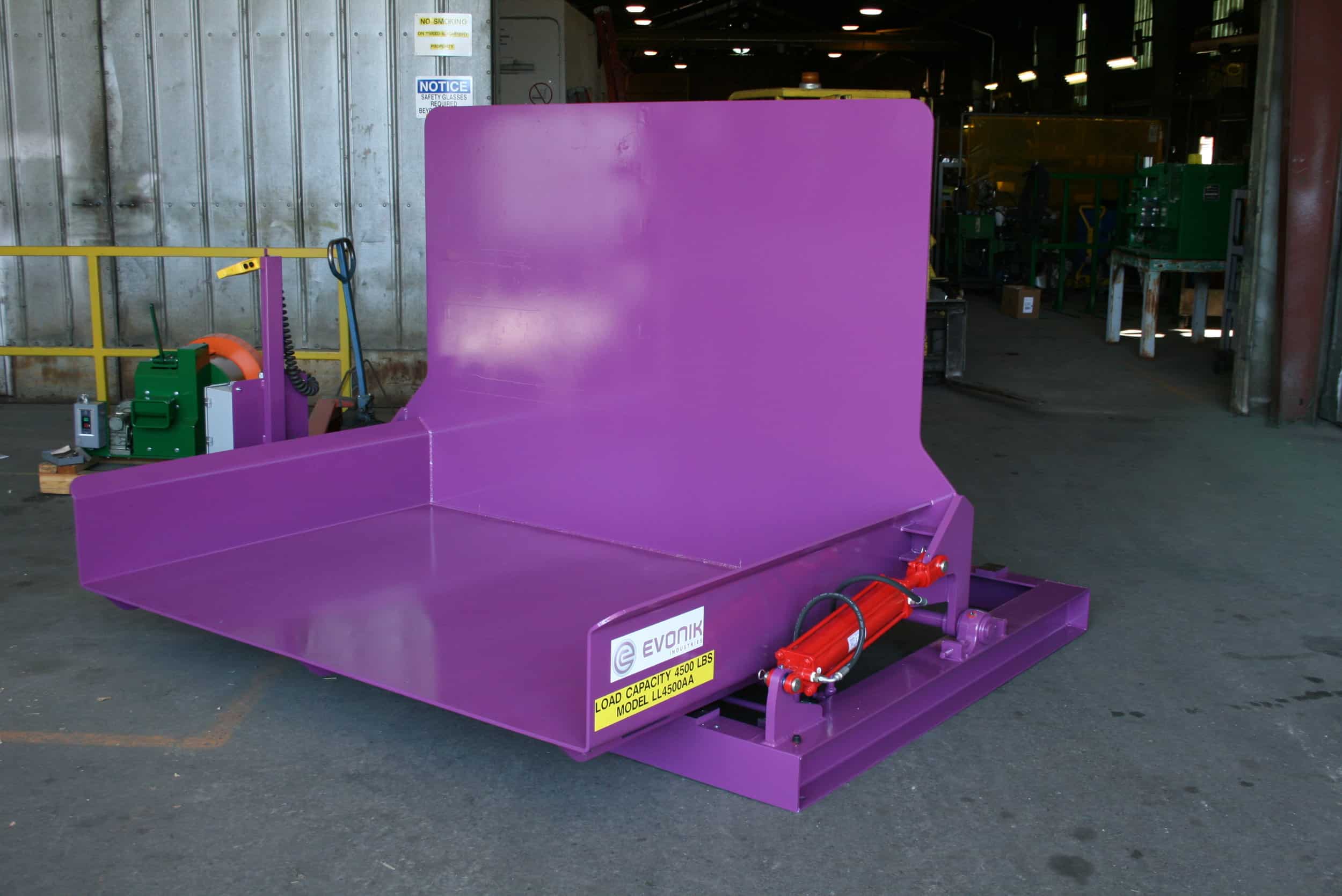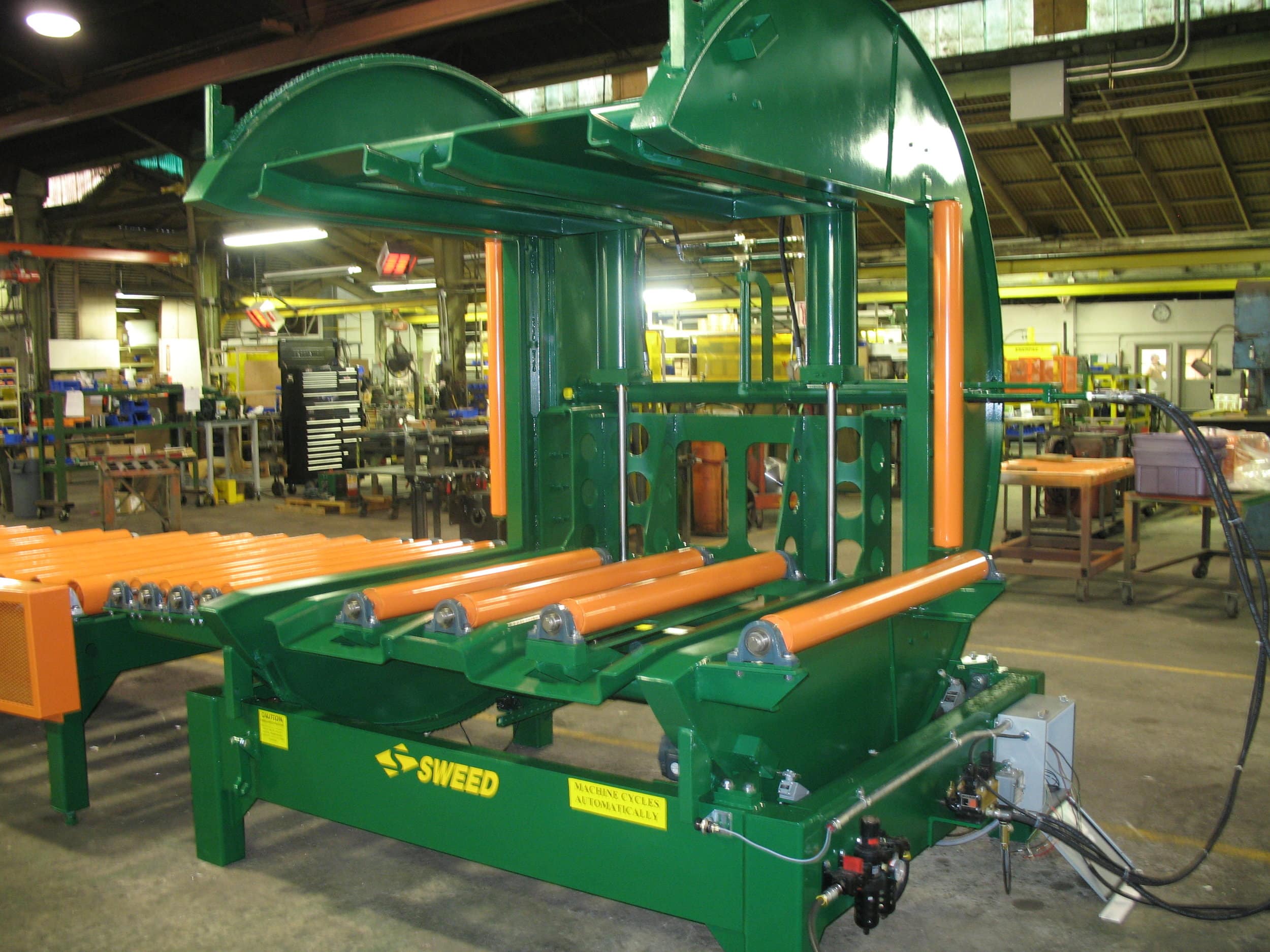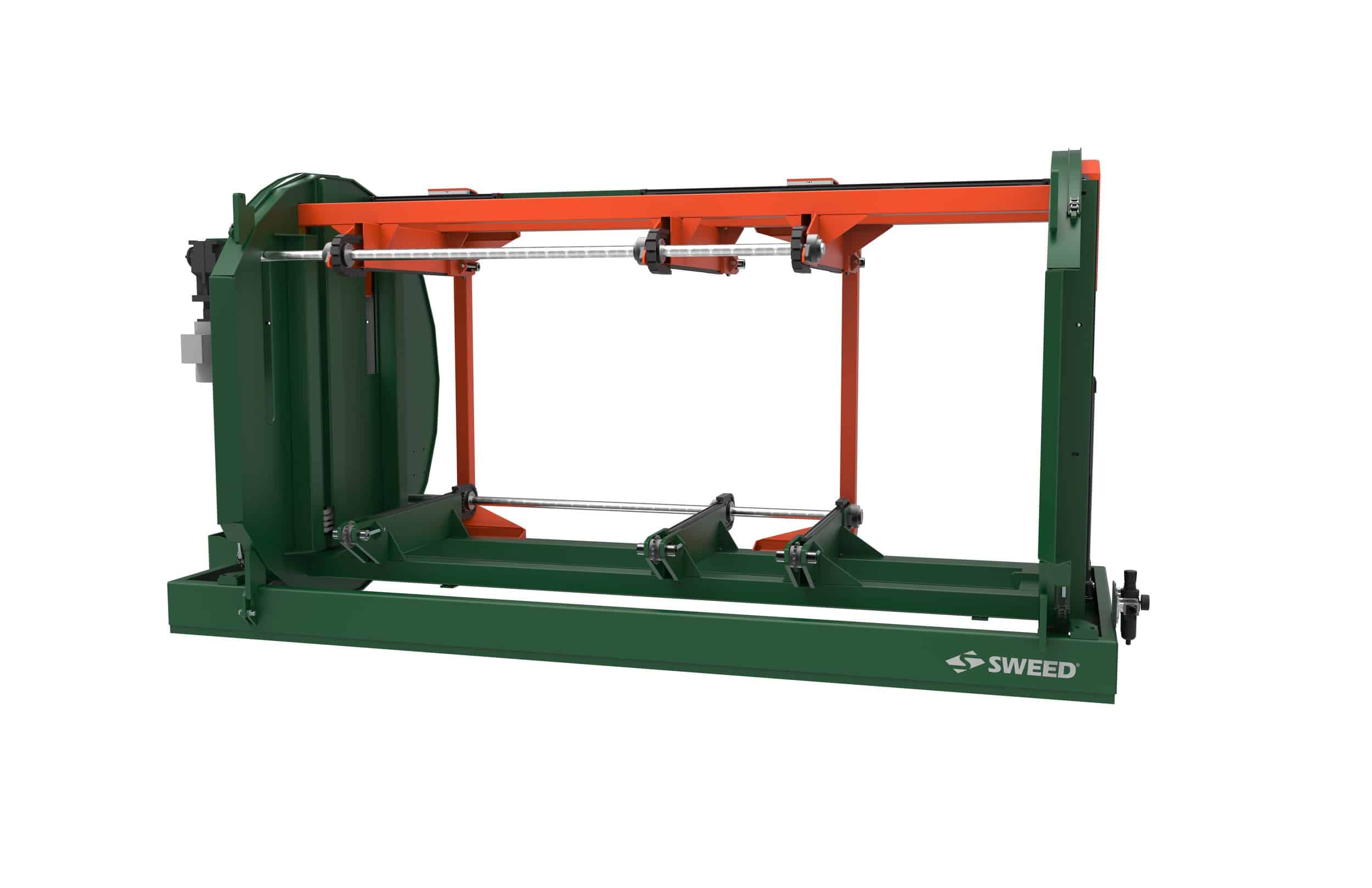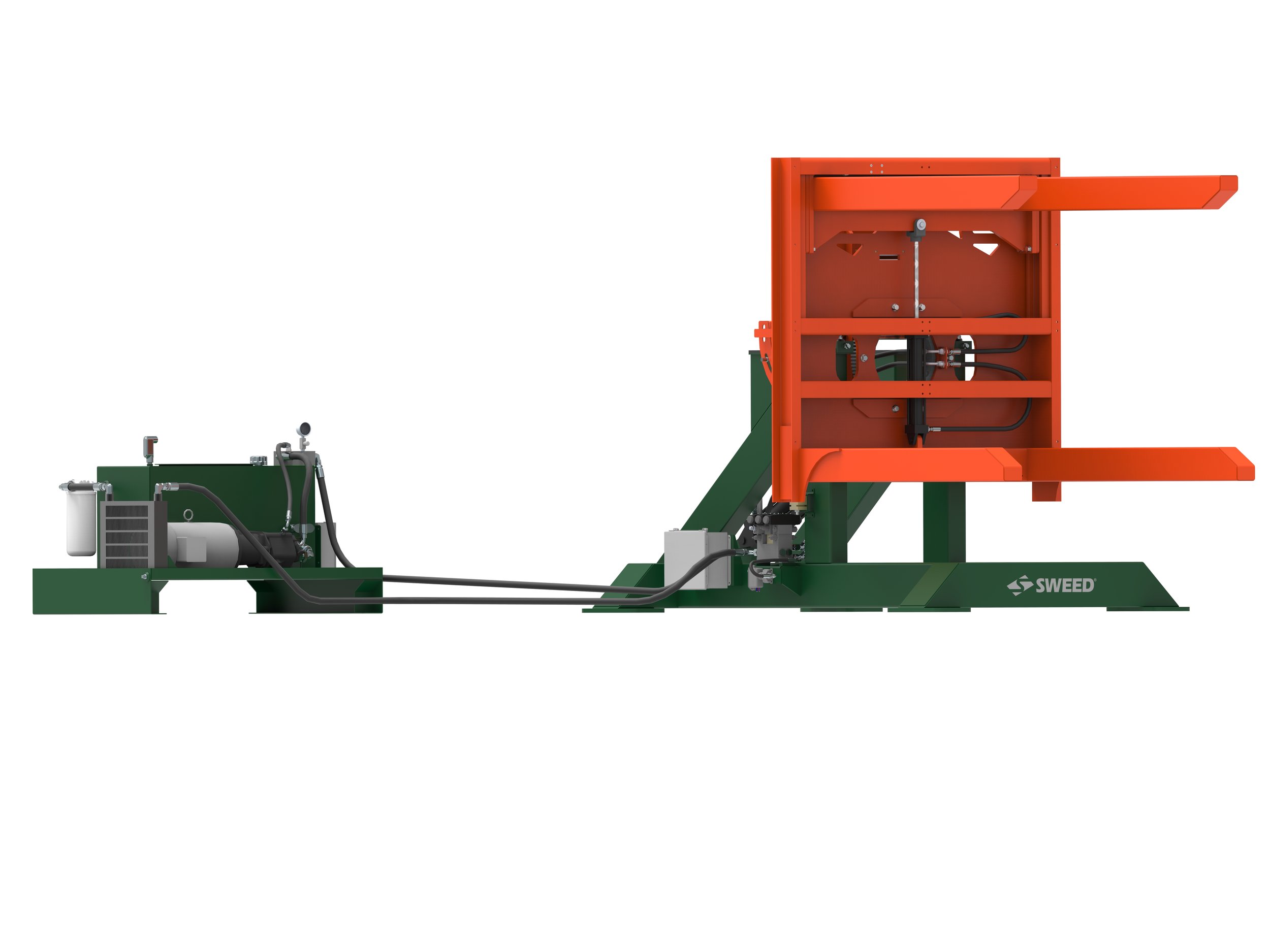New Design Load Turners Boost Productivity, Safety
Written by Del Williams, as seen in Panel World Magazine, March 2010 Issue
For manufacturers of two-sided materials – from flooring, furniture and plywood to metal plates and composite doors – turning stacks of such materials, either side up or side down for processing, has traditionally been done manually. But in today’s ultra-competitive marketplace, such a reliance on manual labor is almost certainly too inefficient and injury-prone.
The sheer size, weight and volume of turning over and processing such two-sided materials can increase labor cost, injury risk, material damage, floor space waste and turnaround time. Back or repetitive motion injury can especially threaten worker safety and company profits.
Now a growing number of proactive manufacturers are turning to load and pallet turners, essential machines that enable the safe, efficient turning and processing of two-sided material of virtually any size, and the easy insertion of pallets onto upturned loads as needed. A new generation of advanced turners is making this possible.
“There’s no way we’d turn the quantity of panel loads we do by hand,” says Lee Larson, Maintenance Manager at the Medford, OR plant of Boise Cascade. “To safely, efficiently turn the volume we do, we use Sweed C-turners.”

Veteran companies such as Sweed Machinery, Inc., a Gold Hill, OR-based manufacturer of panel, veneer and linear reduction equipment, are offering manufacturers a greater variety of turners, customized to their needs: from panel turners, pass thru turners, butterfly turners, and L-turners to C-turners, giant C-turners, and rotating C-turners,” says Charlie Smith, material handling sales representative at Sweed. “Many are looking to turners to improve productivity, safety and costs. A new generation of turners that are up to 40% less costly than traditional equipment is making them a popular choice even for those who have never considered them before.”
Larson adds, “A forklift driver can simply place a load in a C-turner, push a button, and safely pick up a turned load on the other side in under a minute.”
A roll-case outfeed allows more than one load to cue for the forklift, enhancing process efficiency. A double load turner further helps process efficiency, by turning two loads at once, which can keep multiple machine centers busy.
“There’s no way we’d turn the quantity of panel loads we do by hand,” says Lee Larson, Maintenance Manager at the Medford, OR plant of Boise Cascade. “To safely, efficiently turn the volume we do, we use Sweed C-turners.”
Veteran companies such as Sweed Machinery, Inc., a Gold Hill, OR-based manufacturer of panel, veneer and linear reduction equipment, are offering manufacturers a greater variety of turners, customized to their needs: from panel turners, pass thru turners, butterfly turners, and L-turners to C-turners, giant C-turners, and rotating C-turners,” says Charlie Smith, material handling sales representative at Sweed. “Many are looking to turners to improve productivity, safety and costs. A new generation of turners that are up to 40% less costly than traditional equipment is making them a popular choice even for those who have never considered them before.”
Larson adds, “A forklift driver can simply place a load in a C-turner, push a button, and safely pick up a turned load on the other side in under a minute.”
A roll-case outfeed allows more than one load to cue for the forklift, enhancing process efficiency. A double load turner further helps process efficiency, by turning two loads at once, which can keep multiple machine centers busy.

“The C-turners are an essential, virtually maintenance-free part of our process, and have helped us to maximize our capacity,” says Larson.
A while back the Swanson Group aimed to streamline its process and enhance safety at its Glendale, OR plant with traditional turners. While safe and more efficient than manual labor, these turners still left something to be desired.
“The old turners’ clamping process was overly complicated, requiring a timer and multiple steps,” says Ken Tocher, Maintenance Director of they plywood/veneer division at the Glendale plant. “If the forklift operator didn’t properly center the load in the turners, or if the air leaked, the load would sometimes spill out like a deck of cards.”
When the Glendale plant turned to C-turners by Sweed, they found the design sped their process and enhanced safety. Broad, air-driven clamping forks hold the load firmly in position while moving. With a fail-safe design, the load remain secure even if air and electricity fail.
“Loads are clamped securely and everything is captured in the bottom pocket of the C-turners when they roll up,” says Tocher, “I’ve never seen a spill, and they’ve eliminated a few steps in the turning process.”
To maximize productivity within existing warehouse space, a C-turner with a rotating base allows lift operators to load, turn and retrieve material from the same side. “This allows us to place the C-turner in the corner against a wall, since it eliminates the need for forklift operators to drive to the other side for unloading,” says Tocher.

A pass-through load turner positioned in the middle of a conveyor line further speeds production by turning loads from the hot presses in less than 30 seconds, according to Tocher.
“We’ve improved employee safety, throughput, and material handling with the Sweed turners, compared to the old ones,” says Tocher. “We’ve eliminated some bottlenecks and turn about 10 more loads per shift.”
Recently, manufacturing specialists such as Sweed have customized turners to accommodate bigger, heavier loads in response to OSB manufacturers producing larger units. Some of these new turners can accommodate a 5 ft. x 12 ft. load at 7,000 lbs. compared to a standard turner that holds a 4 ft. x 8 ft. plywood unit at about 3,500 lobs. The new turners also offer hydraulic clamping and rotating, versus the traditional method of air.
For instance, the company built a turner for Ashley Furniture in Arcadia, WI. Ashely’s C-Turner was developed because they needed a machine that would turn the load over but keep the wood grain running in the same direction. Sweed accomplished this by using a roll-case outfeed. For efficiency, they used one 5 HP hydraulic unit to power everything: the motor to turn the load, hydraulic cylinders to clamp the load, and another hydraulic motor to run the rolls. The turner has a 7,000 lbs. capacity, and in its current configuration can accommodate loads from 19 in. to 41 in. tall, up to 5 ft. wide, and from 6 ft. to 12 ft. long.
While turner size, capacity, material handling and outfeed are customizable, new designs have the greatest potential to boost productivity and safety for manufacturers, especially for those who felt priced out of the market.

Take, for example, the new Bundle Turner from Sweed, which was designed and engineered from scratch to be the most effective, cost efficient, and easiest to maintain load turner available. The compact unit takes up less floor space than a standard C-Turner yet loads and unloads on the same side like a much larger rotating C-Turner. With an open design, all its operating components are within easy reach for inspection, maintenance and repair, unlike larger, traditional, closed design turners.
“Manufacturers looking to turn up productivity and safety to compete in the marketplace owe it to themselves to see how much they can improve their processes with the new generation of load and pallet turners,” says Smith of Sweed.

